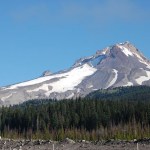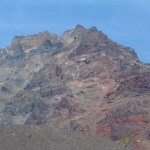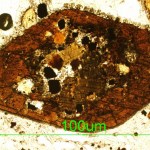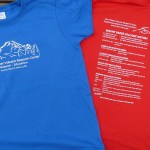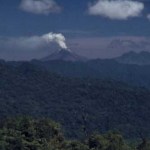cascades
Mt. Hood in Oregon, taken August 2008. Image by Erik Klemetti. Click on the image to see a larger version.
Quick news!
I'm not going to go into too much depth right now about the recent study published in Nature Geoscience on Mt. Hood in Oregon - I plan to talk about it more in a few weeks. Why is that? Well, the lead investigator on the study, Dr. Adam Kent of Oregon State University, is a friend of mine (and occasional Eruptions commenter) so I plan to get the details from him before posting. I was also peripherally associated with some of this work - mostly in the field acting as a pack…
The northern Chilean and southern Peruvian Andes are full of volcanoes that look stunning - I mean, jaw-dropping details of volcanism litter the landscape. The reason for this is two fold: (1) there is an awful lot of volcanism in the northern Chilean/southern Peruvian Andes (as known as the Central Volcanic Zone) - and has been that way for over 10 million years and (2) it has also been very, very dry in the area (most of which is known as the Altiplano-Puna Plateau) for at least a few millions years as well - it is the home of the Atacama Desert! So, this means you get lots of volcanic…
A few very quick hits:
Ever-looming Mt. Rainier, with Tacoma, Washington in the foreground.
PHIVOLCS is pondering whether to lower the Alert Status at Taal back to Level 1. The volcano has been on Alert Level 2 for the past month after increasing signs of potential eruptive activity. However, seismicity is down at Taal, so PHIVOLCS will be sending a ground team to do a survey before deciding whether to lower the Alert Level. The heightened state of alert at Taal has lead to some people taking advantage of the populace, with little more than a fake text message to cause panic.
Just how tall…
So, I've had requests on the blog to help to do some defining of volcanologic terms on the blog, so I thought I'd try a new column called Eruptions Word of the Day. I'm not sure how often it will run, but let's give it a try.
Eruptions Word of the Day for July 5, 2010: Dacite
Dacite is a magma type defined by silica (SiO2) content between 63-68 (or 69) weight percent. That is the textbook definition, but some other typical characteristics of dacite lavas (or magmas) is the presence of certain minerals: plagioclase feldspar and hydrous minerals (containing water in their mineral structure)…
Last year I mentioned the fundraiser for the excellent Mt. Baker Volcano Research Center - and lo and behold, I will mention it again. The new 2010 t-shirts are out and you can purchase one to support one of the best volcano research sites on the web (and off the web) - with a plethora of information on Mt. Baker, updates on the research going on at the volcano and any news of activity from Washington's northern-most volcano.
2010 MBVRC t-shirt. Click to enlarge image.
This year's t-shirt features Mt. Baker's eruptive history (see above) and can be yours by visiting the MBVRC blog site. You…
News, news, news!
Ash from Eyjafjallajökull piling up on a roof at Seljavellir. Image courtesy of the IMO, by Ari Tryggvason.
The latest from Eyjafjallajökull has the volcano continuing to puff away - producing intermittent airspace closures over Europe. The Icelandic Met Office reports a ~7 km (21,000 foot) ash plume, but they note that the explosivity of the eruption seems to have waned some since a maximum on May 13. Right now, the IMO estimates the eruption rate at ~200 tonnes/second. Lets put that in a little perspective - a Ford F-150 pickup weighs about 2 tonnes, so the volcano is…
Part 2 of your recollections of the May 18, 1980 eruption of Mount St. Helens.
You can read Part 1 here.
You can also check out an amazing set of satellite images spanning 1979-2010 at the NASA Earth Observatory. Great stuff!
-------------------------------------------------------------------------------------------------
Eruption plume from Mount St. Helens on May 18, 1980. Image courtesy of the USGS/CVO.
Peter Carlton
My sister and I were playing in our backyard in West Seattle when we heard the boom. I was 6 years old. I remember lots of phone calls with our relatives in Yakima, watching…
Some news for a sleepy Monday:
Mt. Hood in Oregon.
The ash from Eyjafjallajökull is, once again, causing significant airspace closure over northern Europe - close of 1,000 flights today. However, much of the closures are fairly short-lived, but that isn't keeping people happy. The eruption hasn't actually changed much, just that the winds are bringing ash towards Europe. The ash for the next few days will likely effect the England, Scotland, Ireland, Netherlands, France and possibly other parts of northern Europe (along with airspace over Greenland and the north Atlantic). The ash plume is…
May 18, 2010 marks the 30th anniversary of the dramatic eruption of Mount St. Helens in Washington state. Now, rather than recount the event when the USGS and the Cascade Volcano Observatory have done such an excellent job, I turn it over to all the Eruptions readers and their memories of the eruption.
Now, as I've mentioned, I was all of three years old when St. Helens erupted in 1980, so I have no distinct memories of the eruption. My mother has mentioned that she watched the TV coverage with me and my sister, who had been born a two months earlier. However, the real memories of St. Helens…
Time to play a little catch up ...
Eyjafjallajökull erupting in early May. Image by and courtesy of Martin Rietze.
A brief update on our friend Eyjafjallajökull - the eruption plume from the volcano was considerably taller yesterday, reaching 6-9 km (20,000-30,000 feet), but prevailing winds meant the ash hazard was confined to areas in the middle of the North Atlantic and northern parts of the British Isles. However, even as the ash hazard for Europe wanes (for now), you shouldn't forget the amount of ash being dumped on parts of Iceland. If you want to see some stunning images of the…
Mount St. Helens erupting in 1980.
Just a reminder ... please send them to me by May 15 so I can get them all ready for the post on the 18th!
As many of you might (or might not) now, we're heading towards the 30th anniversary of the dramatic eruption of Mount St. Helens in Washington state. Now, I could fill a book with the information out there on the volcano and the eruption, but instead, I think it would be more interesting to get your takes on the eruption. I have to admit, I was all of three when the eruption occurred, so my memories of the event are hazy at best, but if you have any…
Mt. Saint Helens erupting in 2004.
I had a chance to watch a new NOVA special that airs May 5 (PBS) on the 1980-1986 and 2004-2008 eruption cycles at Mt. Saint Helens, along with the recovery of the blast zone from the 1980 eruption. It is a fitting episode as we approach the 30th anniversary of the eruption that took out the north side of the volcano and devastated a vast swath of Cascade wilderness in Washington on May 18, 1980. Many of you have already sent me your Mt. Saint Helens memories (keep them coming!) for my tribute to the eruption, but if you want to get started on remembering…
Mt. Saint Helens erupting in 1980.
As many of you might (or might not) now, we're heading towards the 30th anniversary of the dramatic eruption of Mt. Saint Helens in Washington state. Now, I could fill a book with the information out there on the volcano and the eruption, but instead, I think it would be more interesting to get your takes on the eruption. I have to admit, I was all of three when the eruption occurred, so my memories of the event are hazy at best, but if you have any memories, reactions or thoughts you want to share on the events leading up to the eruption, the eruption…
News!
Colima in Mexico erupting in 2008.
The current activity at Eyjafjallajökull is more-or-less unchanged, with strombolian activity producing a 3-4 km tall ash-and-steam plume and the lava flows at the crater moving northward towards the GÃgjökull glacier. You can check out an extensive page on the state of this eruption at the Nordic Volcanological Center - along with a new page with thermal and LIDAR information on the eruption from France.
The Icelandic Met Office notes that the lava has been producing meltwater from the glacier - which many Eruptions readers have noticed as floods…
Hard to believe, but there is other volcano-related news in the world ...
So, with all deference to Eyjafjallajokull, here it is:
Dome collapse on Colima in Mexico, image taken March 30, 2010.
The new Smithsonian/USGS GVP Weekly Volcano Activity Report was issued, with news about increasing signs of activity at Egon in Indonesia, a possible plume at Miyakejima in Japan and more dome growth at Soufriere Hills.
A study on the economic effect of a new Vesuvius eruption was released and the finding show the potential for a staggering $24 billion of economic damage directly related to an…
Ever wonder if acts of kindness or malice really do ripple outwards? If you give up a seat on a train to a stranger, do they go onto "pay it forward" to others? Likewise, if you steal someone's seat, does the bad mood you engender topple over to other people like a set of malicious dominoes? We'd all probably assume that the answers to both questions were yes, but James Fowler and Nicholas Christakis think they have found experimental evidence for the contagious nature of cooperation and cheating.
The duo analysed data from an earlier psychological experiment by Ernst Fehr and Simon Gachter…
Mt. Baker in the northern Cascades of Washington.
One of the best websites dedicated to any volcano is the Mt. Baker Volcano Research Center - hosted by Western Washington University. I've talked about it before, but David Tucker and his associates have put together an excellent resource on this (at least in my opinion) woefully underappreciated Cascade volcano.
There is a pile of news from the MBVRC and I thought I'd pass it along.
First off, the 2010 T-shirt design contest has kicked off. Last year the MBVRC raised much needed funds with a T-shirt sale and now you can try to design the…
Here it is, my attempt to recap a year's worth of volcanic events. By no means is this supposed to capture every event, but rather the highlight/lowlights and what most captivated me during 2009. I'll be announcing the winner of the 2009 Pliny for Volcanic Event of the Year tomorrow.
Waimangu Geothermal Valley in New Zealand, taken in January 2009 by Erik Klemetti.
January
The year started out with a trip to New Zealand (well, for me at least) and vistas of the Waimangu Valley, formed in the 1886 eruption of Tarawera on the North Island. We were also still thinking about the late 2008…
It has been a slow week for volcano news (and a busy week for me), so I apologize for the abundance of MVPs this week. I've tried to find a good one in the many images submitted to me by Eruptions readers, and #15 is just one of those photos. If you have images you'd like to share with me for MVP or other uses, please email them to me at
. (However, I should note that you can't win by identifying your own volcano photo!)
MVP #13 was Lava Butte near Newberry volcano in Oregon. It is a lovely small scoria cone that you can walk/drive to the summit. From there, you get a spectacular view of the…
The southern Washington (and northern Oregon) Cascades, with Hood (foreground), St. Helens and Adams (middle) and Rainier (background).
Remember a few months ago when an abstract from a meeting got people are ruffled because the study said there was a "giant magma chamber" feeding all three of St. Helens, Adams and Rainier in the Cascades? Well, Nature Geosciences has been kind enough to publish the work (the article) and yes, yet again, we can say it is still most likely not true at all.
Graham Hill and others claim that their magnetotelluric work in the Cascades show that a vast magma…
